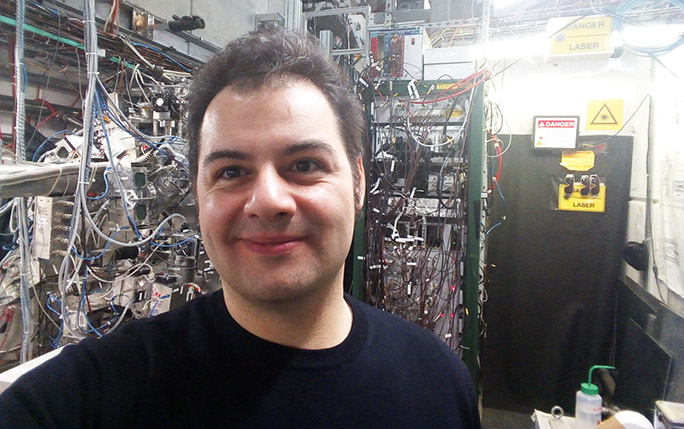First AVA Fellow Graduated

AVA Fellow Mattia Fanì (based at CERN) recently earned his PhD in Physics. His thesis is titled Pulsed antihydrogen production for direct gravitational measurement on antimatter and a summary of his work can be found below.
Background – One of the biggest efforts of the antimatter community is to measure gravity on a neutral antimatter system for a direct test of the validity of Einstein’s Weak Equivalence Principle. Electrically neutral antimatter systems are expected to behave in exactly the same way as their matter counterparts. To date, however, the question of whether antimatter falls in the Earth's gravitational field with the same acceleration g as ordinary matter does not yet have a direct experimental answer.
Antihydrogen is the bound state of an antiproton and a positron. It is the simplest antimatter atom - and the only one ever synthesised. In AEgIS, antihydrogen is formed through charge-exchange reaction between cold trapped antiprotons and a cloud of Rydberg-excited positronium. Positronium (Ps) is a purely leptonic hydrogen-like bound state composed of an electron and a positron.
Summary – As part of his thesis, Mattia presented the first pulsed formation of antihydrogen, achieved in AEgIS as a core topic of his work. He was a member of the AEgIS Collaboration and part of the AEgIS Antiproton Group. Pulsed antihydrogen production is the crucial achievement to validate the AEgIS experimental approach to perform the gravity measurement on antimatter. This achievement opens up the possibility to measure the atoms' time-of-flight, unavailable from currently available trap-based methods.
The AEgIS Antiproton Group is responsible for the trap system; the main system of the experimental apparatus. The electronics of all the other systems depend on that of the trap system. Mattia strongly contributed to the developments on antiproton manipulation procedures and related detection techniques. Among the results of his thesis, an outstanding antiproton plasma compression was obtained, allowing the movement of antiproton clouds into the production trap in suitable conditions for the formation of antihydrogen and its detection.
Detectors are required in order to resolve the vertical displacement in the arrival position of antihydrogen, through detection of its annihilation products which ultimately is the detection of the annihilation products of an antiproton. A dedicated low-energy antiproton beam line and a test stand facility were built to test various detection technologies for the gravity module of the AEgIS experimental apparatus. Mattia carried out a simulation with realistic parameters based on pre-existing work to provide an estimation of the beam parameters required for detector exposures to low-energy antiprotons. He defined a map for antiproton arrival position and energy for detector exposure experiments of four different energy ranges, allowing more efficient experiments for tests of antihydrogen detector candidates.
Several novel detection techniques were implemented in the positronium diagnostics. In particular, the use of a kicker pulser to detect the charge induced by the passage of the positron bunch was developed, tested and used as a main technique to monitor the condition of the positrons entering the main apparatus. On the top of this, the conversion of a Micro Channel Plate (MCP) into a position sensitive detector for slow positronium allowed to characterise the Rydberg state of this unstable atom in a magnetic field. The work for the fine tuning and characterisation of the new detection techniques was part of the activities carried out during the data taking period.
Mattia also evaluated and reported on the possibility to use a novel scintillating material in the detection of excited positronium produced in the antihydrogen production region to fully overcome the present existing limitations. An extensive characterisation of the material was completed and a detector coupling such scintillator with a fast response photomultiplier tube was assembled. Such detector succeeded in detecting the formation of positronium and gave encouraging results for the detection of the elusive Rydberg-Ps states in magnetic field. Mattia has written an internal report on this activity, as well as a manuscript (currently under internal review) for submission to a technical newspaper.